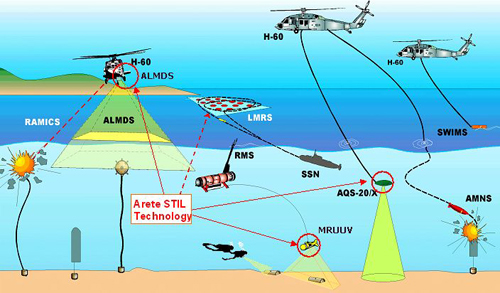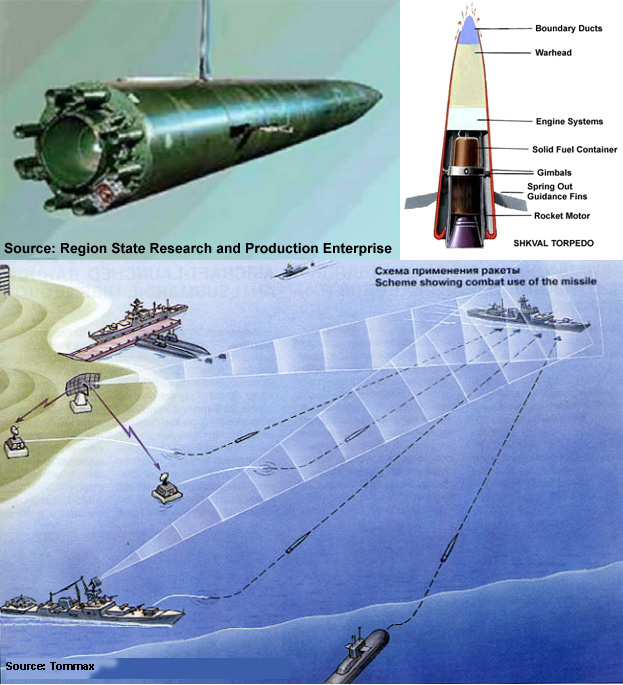”...demonstrate stable and controllable high-speed underwater transport through supercavitation. The intent is to determine the feasibility for supercavitation technology to enable a new class of high-speed underwater craft for future littoral missions that could involve the transport of high-value cargo and/or small units of personnel. The program will investigate and resolve critical technological issues associated with the physics of supercavitation and will culminate in a credible demonstration at a significant scale to prove that a supercavitating underwater craft is controllable at speeds up to 100 knots.”
James Bond is officially jealous, Q’s insurance division is cringing, and a pair of American defense contractors could be $78.6 million richer if the contracts they’ve just received pan out. We explain “supercavitation,” and detail the contracts involved…
Supercavi-fragile-istic?
While transitions from normal underwater travel into
the supercavitating regime and back out again can be accomplished by gradually
expanding and contracting the bubble, reaching supercavitation speed takes
a lot of energy, and maneuverability that would both force and require
the bubble to change shape is a far trickier challenge. The Shkval is not
believed to have maneuver capability, for instance, leading to speculation
that its original tactical concept may have involved firing a Shkval equipped
with a tactical nuclear warhead into a US carrier battle group. This could
make the Shkval something of a suicide weapon, but unlike a cruise missile
the carrier group would have no defense once it was fired. A radical tactic,
to be sure; but then, the necessity for an accurate straight shot limits
the viability of other tactical scenarios.

AMCM Components
..
DARPA’s Underwater Express program offers a very different focus – and a much harder challenge, since any manned supercavitating system would have to be maneuverable and the Underwater Express program explicitly calls for something that is “controllable at speeds up to 100 knots.” At those speeds, the margin of error for a manned craft will be slim to none; “DARPA-hard” could end up describing a lot more than the research if something goes wrong with a production system. The total lack of acoustic stealth also makes one wonder about the manned supercavitation concept for special forces insertion et. al. in the oceans, while the dangers of navigating high-traffic large rivers at those speeds make one wonder about the concept beyond the oceans.
Still, DARPA obviously believes there’s a point to it all, because they’re going ahead with full-fledged demonstrator production contracts.
Underwater Express: The Contracts

Nov 6/06: General Dynamics Electric Boat, Corp. in Groton, CT received a $5.75 million cost-plus-fixed-fee contract for research and development to support the Underwater Express program. This contract contains two options that would bring the cumulative potential value of this contract to $37.1 million in exercised.
Work will be performed in State College, PA (37%); Groton, CT (24%); McLean, VA (14%); Reston, VA (10%); Bethesda, MD (12%); and Newport, RI (3%), and is expected to be complete October 2007. Contract funds in the amount of $3.4 million will expire at the end of the current fiscal year. (N66001-07-C-2002).
Nov 6/06: Northrop Grumman Corporation Electronic Systems in Annapolis, MD received a $5.4 million cost-plus-fixed-fee contract for research and development to support the Underwater Express program. In Phase 1 of the contract, which will last for 13 months, Northrop Grumman and its teammates will establish the technology basis for supercavitation transport through a series of testing and modeling activities, and produce a concept design for an underwater demonstrator vehicle.
This 13-month contract also includes two 15-month options; Phase 2, worth up to $17 million, would include continued technology research at a larger scale and establish the detailed design of the demonstrator vehicle. Phase 3, worth up to $23.4 million, would include building a Demonstration Super-fast Supercavitating Transport (DSST) vehicle which would operate at 100 knots for durations of up to 10 minutes. The cumulative, potential value of this contract including both options is $45.8 million.
Most of the work will be divided between Northrop Grumman’s Undersea Systems facility in Annapolis, Md., and Pennsylvania State University’s Applied Research Laboratory in State College, PA. Other organizations contributing to the team include the University of Minnesota, the University of Maryland, the Navy’s Naval Undersea Warfare Center in Newport, RI, and BBN Technologies of Cambridge, MA. Work will be performed in Annapolis, MD (50%); State College, PA (42%); Sunnyvale, CA (4%); College Park, MA (1%); Minneapolis, MN (1%); Cambridge, MA (1%); and Newport, RI (1%), and the expected completion date is September 2007. Contract funds in the amount of $2.5 million will expire at the end of the current fiscal year (N66001-07-C-2003).
Additional Readings & Sources
- Scientific American (May 17/01) – Warp Drive Underwater. Very good treatment of defense applications.
- Space.com (Oct 11/00) – Supercavitation.
Discusses weapons programs, as well as other potential applications that
include ocean farming and even the exploration of Jupiter’s moon Europa,
which may have the conditions required for life beneath its icy oceans.
© 2004-2008 Defense Industry Daily, LLC in association with Watershed Publishing, LLC


